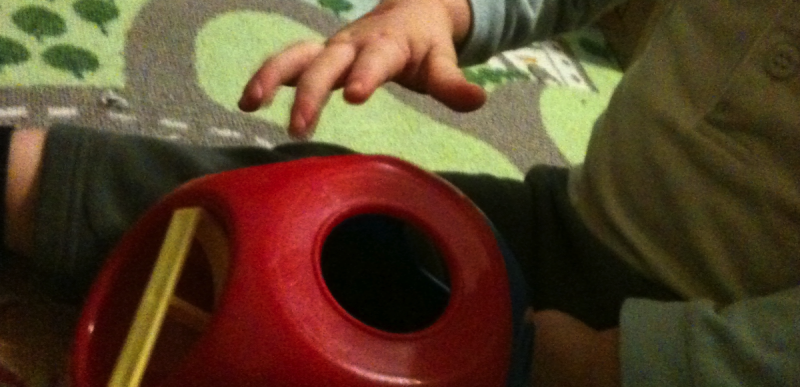
As I watched my son over the past few days learn about shape, I am struck by not only how much we need to learn to make sense of the world, but also by how even simple things cannot be taken granted as known by children.
My youngest son, who is about 20 months old now, is learning how to take a small piece of yellow plastic that forms a shape (an oval, a circle, a hexagon, and 4 other shapes) and push it through a hole that is only slightly larger than the shape he is pushing through it. The task requires him to pay close attention to both the shape he has in his hand, the orientation of that shape, and the hole he is trying to force it through.
At first he pretty much chooses shapes at random, and tries to jam into the hole. Eventually he finds a match and gets a shape through the hole, or he gives up. He rarely turns the shape in his hand, or the container the shape goes into.
Eventually he learns that he has to often rotate the shape in his hand, and so he picks up a random shape and tries to shove it in a random hole, and when it doesn’t work the first time, he says, “No…no…no,” and rotates the shape a bit to try again.
Soon he has made a few matches, and is always able to easily find the right hole for the circular shape and the oval shape, and soon after the plus sign shape. For all of the other shapes, he continues to try to randomly match shapes to holes. He looks at the shape to identify it as one of the ones he knows, but he does not seem to connect the general idea that the shape he sees in the piece should match the shape he sees in the hole.
The next day, I am surprised to discover that he can match almost all of the shapes, and frequently looks at the shape to see which one he has, and then which hole he should put the shape in. He often rotates the shape several times when he is sure he has the right hole. When he is not sure, he tends to give up quickly and go back to a shape with which he is very familiar.
In a few days, he goes from basically using a random matching strategy to carefully looking at the shape in order to be able to match it. At this stage the only shapes that stump him regularly are the regular pentagon, and the regular hexagon.
I notice however that his ability to do other puzzles does not seem noticeably improved. It’s like his learning is restricted to this one very narrow context, and within this narrow context, he has either just learned to match each of the individual patterns or possibly he recognizes a small generalization; for this puzzle the shape should match the hole. As the months progress, I will continue to watch how his understanding of shape grows and develops.
It is fascinating to me to see that shape is a learned concept and that even what seem like simple generalizations are learned. It makes me wonder what concepts my students may not have fully developed, even by the time they arrived to me in high school.
Maria Droujkova says:
Yay, great example of situated abstraction!
I have a rule of thumb called “The Rule of Three” – it takes three or more different contexts before you see transfer to new ones. Even then it’s far from automatic.
For example, cooking in someone else’s house is hard. You don’t automatically know which knife is good for which vegetable, or which bowl is large enough for that family, or which board won’t slide. And you can’t easily tell just by looking, even if you are experienced with knifes, volumes, and properties of wood and plastic.
November 19, 2013 — 4:42 am